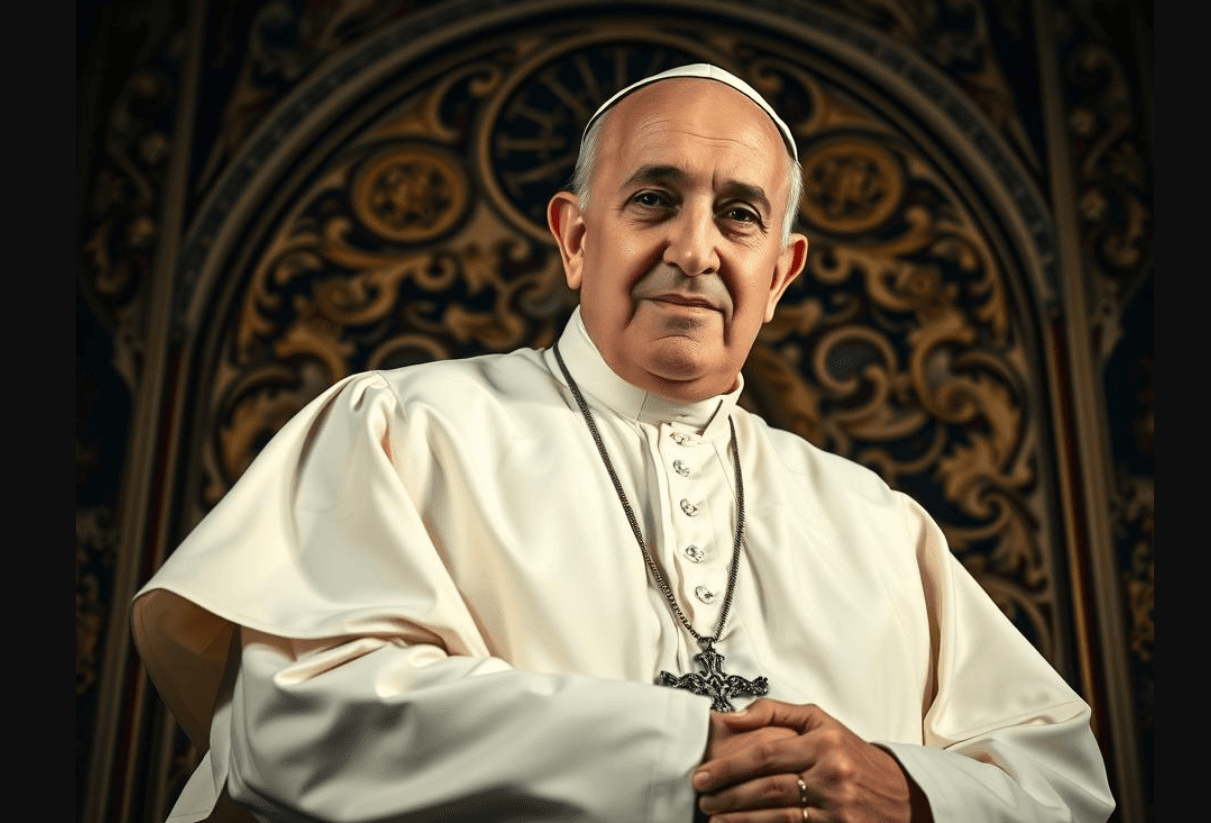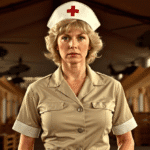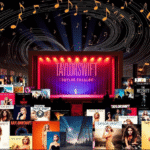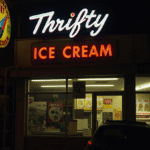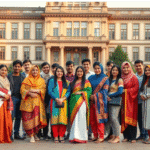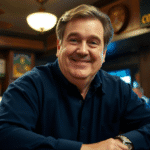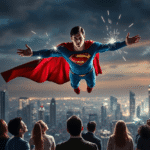Table of Contents
Few leaders have shaped the Roman Catholic faith as profoundly as the first pope from the Americas. Born in Buenos Aires, his journey from humble beginnings to the Vatican reflects a life dedicated to compassion and change. His influence reaches far beyond the Catholic Church, touching hearts across the world.
Known for his simplicity and warmth, he broke barriers as the first Jesuit pontiff. His focus on social justice and environmental care redefined modern leadership. From reforming the Vatican to fostering interfaith dialogue, his actions spoke louder than words.
We remember his unexpected rise to the papacy and the lasting mark he left. His legacy continues to inspire millions, proving that humility and courage can transform the world. For more on his impact, explore his historic milestones.
Introduction: A Humble Leader Who Changed the Church
A breath of fresh air swept through the Catholic Church in 2013. Elected after Benedict XVI’s resignation, the new pontiff chose a name honoring St. Francis of Assisi—a saint known for simplicity and love for the poor. This signaled a shift from tradition.

His informal style stood out. Unlike predecessors, he preferred a modest residence over the grand papal apartments. The Domus Sanctae Marthae became his home, reflecting his belief in walking alongside people.
His motto, “Miserando atque eligendo” (“By having mercy and by choosing”), came from Matthew 9:9-13. It underscored his focus on compassion—a theme defining his papacy. From climate action to LGBTQ+ dialogue, he challenged norms while honoring faith.
| Traditional Papacy | His Innovations |
|---|---|
| Formal attire and rituals | Simple vestments, casual greetings |
| Apostolic Palace residence | Domus Sanctae Marthae community living |
| Focus on doctrine | Emphasis on mercy and social justice |
Tensions arose between reform and tradition. Yet his life of service—from Buenos Aires to the Vatican—proved authenticity. The world took notice as he redefined leadership with humility.
Early Life: From Buenos Aires to the Jesuit Order
The journey of the first Latin American pontiff began in the vibrant streets of Buenos Aires. Born on December 17, 1936, to Italian immigrants Mario Bergoglio and Regina Sívori, his Piedmontese roots grounded him in hard work and faith. Their small home in Flores neighborhood buzzed with love and resilience.

Childhood and Family Background
Mario, a railway worker, and Regina, a homemaker, instilled humility early on. Young Jorge helped his father with accounts, learning the value of diligence. Sundays meant Mass and shared meals—a blend of Argentine culture and Italian traditions.
Health Struggles and Spiritual Awakening
At 21, severe pneumonia led to a partial lung removal. Bedridden for months, he found solace in books about saints. A street confession during this time ignited his calling. “I felt mercy wrapped around me,” he later recalled.
Joining the Society of Jesus
By 1958, he traded chemistry labs for Jesuit vows. Mentor Stefan Czmil, a Ukrainian Greek Catholic priest, deepened his love for service. Early jobs—bouncer, janitor—kept him tied to the working class, foreshadowing his future path.
- Key Influences: Parents’ work ethic, Czmil’s mentorship.
- Defining Moments: Illness, street confession.
- Early Jobs: Chemical technician, nightclub security.
The Jesuit Years: Formation and Leadership
Behind every great leader lies years of unseen formation and struggle. For the first Latin American pontiff, the Catholic Church’s future was shaped in Jesuit classrooms and Argentine slums. His path blended rigorous study with real-world trials.

Education and Early Priesthood
Ordained in 1969, he immersed himself in theology and philosophy. At Frankfurt’s Sankt Georgen seminary, he grappled with European intellectualism. Yet his heart remained tied to Buenos Aires’ marginalized.
Early assignments—teaching literature, mentoring novices—honed his pastoral style. He championed “popular religiosity,” blending faith with local culture. This later clashed with liberation theology’s political focus.
Provincial Superior of Argentina
From 1973–79, he led Argentina’s Jesuits amid the Dirty War’s chaos. His strict governance drew criticism. Some accused him of failing to protect priests like Yorio and Jalics, kidnapped by the regime.
Decades later, a 2005 human rights lawsuit reignited debates. According Vatican archives, he worked discreetly to free prisoners. Critics argued his efforts fell short.
| Jesuit Role | Challenges |
|---|---|
| Seminary Professor | Balancing doctrine with social justice |
| Provincial Leader | Navigating dictatorship dangers |
| Post-1980s Exile | Rebuilding trust after estrangement |
Controversies During the Dirty War
The 1980s estrangement from his order marked a turning point. Shifted to rural parishes, he distanced from politics. Some saw this as pragmatism; others, avoidance.
After Pope Benedict’s 2005 election, scrutiny intensified. Yet his later papacy mirrored Jesuit ideals—mercy over rigidity. Even in death, debates about his Dirty War role persist, underscoring leadership’s complexities.
Rise in the Church: Archbishop of Buenos Aires
In 1998, a quiet revolution began in Buenos Aires with the appointment of a new archbishop. This leader’s blend of pragmatism and compassion reshaped the archdiocese, setting the stage for a historic papacy.

Appointment and Reforms
Facing near-bankruptcy, the archdiocese needed bold changes. The new archbishop sold church-owned bank shares and streamlined budgets. These moves stabilized finances while funding social programs.
He also revived traditional practices, reintroducing the pre-Vatican II Latin Mass in 2007. This balanced innovation with reverence for heritage.
Advocacy for the Poor and Marginalized
Nicknamed the “villero bishop” (slum bishop), he doubled the number of priests in shantytowns. Foot-washing rituals in prisons and hospitals symbolized his hands-on approach.
His focus wasn’t just charity—it was solidarity. “We must smell like the sheep,” he often said, echoing his Jesuit roots.
| Traditional Practices | His Reforms |
|---|---|
| Centralized finances | Decentralized, transparent budgets |
| Limited slum outreach | Doubled priests in impoverished areas |
| Formal liturgies | Mixed Latin Mass with grassroots activism |
Elevation to Cardinal
In 2001, John Paul II named him to the college of cardinals. This recognition reflected his impact in Buenos Aires—and hinted at his future role. Few imagined he’d become pope, but his humility and reforms had already marked him as a unique leader.
The Historic Election of Pope Francis
History was made on March 13, 2013, when the world witnessed an unprecedented shift in the Catholic Church. White smoke over the Sistine Chapel signaled the election of the first non-European leader since the 8th century. Chosen on the fifth ballot, his victory reshaped global perceptions of papal leadership.
Conclave of 2013: A Surprise Choice
Rumors swirled about his 2005 support (40 votes vs. Ratzinger), but few predicted his 2013 triumph. Cardinals sought a reformer after Benedict XVI’s resignation. The Argentine cardinal’s humility—first pope from the Americas—resonated deeply. His election broke barriers, signaling a church embracing global diversity.
Why He Chose the Name “Francis”
The name honored St. Francis of Assisi, reflecting a commitment to poverty and renewal. “I want a poor church for the poor,” he declared. This choice mirrored his Jesuit values, prioritizing service over pomp. It set the tone for a papacy rooted in compassion.
Breaking Traditions: A New Style of Papacy
Change came swiftly. He swapped ornate vestments for simple white cassocks and opted for a Ford Focus over the papal limousine. Rejecting the Apostolic Palace, he chose Santa Marta’s guesthouse, favoring community over isolation. Early appointments of women to key dicasteries further signaled modernization.
- Symbolic Acts: Washing prisoners’ feet, paying hotel bills personally.
- Global Impact: Media dubbed his approach the “Francis Effect.”
- Legacy: Redefined the papal conclave’s role in shaping church direction.
Key Initiatives of Pope Francis
Change often comes from unexpected places, and the modern Catholic Church found its catalyst in groundbreaking initiatives. From redefining mercy to tackling climate change, these efforts left a lasting mark on the world.
Focus on Mercy and Inclusion
His famous phrase, “Who am I to judge?” redefined the church’s approach to LGBTQ+ Catholics. Prison ministries expanded, and the death penalty faced staunch opposition. Mercy wasn’t just preached—it was practiced.
Climate Change and Environmental Stewardship
The 2015 encyclical *Laudato Si’* called the world to protect our “common home.” The Vatican became CO2-neutral, and interfaith climate summits united leaders. Ecology was no longer optional—it was a moral duty.
Reforming the Vatican’s Finances
After the “Vatileaks 2.0” scandal, transparency laws in 2014 overhauled accounting. The church adopted international standards, proving even ancient institutions could modernize.
| Before Reforms | After Reforms |
|---|---|
| Opaque budgets | Public financial reports |
| Cash-based accounting | International auditing |
| Limited oversight | Anti-corruption task forces |
At a critical time for reform, these steps restored trust. The message was clear: faith and accountability could coexist.
Pope Francis and Social Justice
Compassion became the cornerstone of a transformative papacy. The church’s mission expanded beyond doctrine to embrace those on society’s fringes. From migrants to LGBTQ+ individuals, no group was too marginalized for his attention.
Championing Migrants and Refugees
His 2016 visit to the U.S.-Mexico border spotlighted immigration crises. He criticized policies separating families, calling walls “a sign of fear.” The 2020 encyclical Fratelli Tutti urged nations to welcome strangers, framing migration as a moral test.
Critique of Capitalism and Inequality
“An economy that kills“—his Amazon Synod speech condemned unchecked greed. He partnered with homeless shelters during COVID-19, proving faith required action. Wealth disparities, he argued, betrayed the world’s poorest.
Dialogue with LGBTQ+ Catholics
The 2023 Fiducia Supplicans allowed blessings for same-sex couples, signaling inclusivity. Private meetings with transgender people further humanized the church’s approach. “Who am I to judge?” remained his guiding question.
- Legacy: Bridged faith and social justice like no modern pope.
- Impact: Redefined how institutions serve the world’s vulnerable.
Global Diplomacy and Interfaith Efforts
Bridges were built where walls once stood. The modern Catholic Church expanded its reach through groundbreaking diplomacy, connecting faiths and nations. From historic treaties to healing past wounds, these efforts reshaped relations around the world.
U.S.-Cuba Relations
In 2015, decades of tension thawed thanks to backchannel negotiations. According Vatican sources, secret talks between Obama and Castro were facilitated by the church. The Havana embassy reopening marked a new chapter, proving faith could mend political divides.
Meeting with Russian Orthodox Patriarch Kirill
The 2016 encounter in Cuba was the first between world leaders of both churches in 1,000 years. Though Ukraine war tensions later strained ties, this moment showed unity was possible. Shared concerns for persecuted Christians formed common ground.
Addressing Indigenous Rights in Canada
A 2022 apology for residential school abuses began healing with First Nations. Listening sessions with survivors preceded the historic visit. This wasn’t just words—it was active reconciliation for painful colonial legacies.
- UAE Interfaith Declaration: Signed 2019, promoting peace among Abrahamic faiths.
- Myanmar Peace Attempts: Quiet diplomacy during the Rohingya crisis.
- Global Impact: Proved religious institutions could drive change around the world.
Controversies and Challenges
No transformative figure escapes criticism, and the modern Catholic Church is no exception. While many celebrated progressive reforms, others saw departure from tradition. These tensions revealed the complex balance between change and continuity in religious leadership.
Criticism from Conservative Catholics
Traditionalists voiced strong opposition to 2021 restrictions on the Latin Mass. Some saw this as abandoning the church‘s heritage. The “Synod on Synodality” faced similar pushback from groups fearing doctrinal dilution.
Cardinal Burke publicly questioned these changes, reflecting wider conservative unease. Yet supporters argued they maintained unity while allowing cultural adaptation.
Handling of Church Sexual Abuse Cases
The 2019 abuse summit implemented mandatory reporting, but survivors demanded more. When the McCarrick Report revealed past failures, it tested trust in leadership.
Reforms included:
- New tribunal for bishop accountability
- Global guidelines for victim protection
- Transparency measures for financial settlements
Critics noted slow implementation, while advocates saw progress in this painful reckoning.
Political Tensions in Latin America
In Argentina, clashes with President Javier Milei over libertarian policies made headlines. The pontiff’s critique of “savage capitalism” contrasted sharply with Milei’s economic vision.
Nicaragua brought different challenges. After calling out Daniel Ortega’s dictatorship, the church faced government retaliation. These conflicts showed how faith leadership intersects with regional politics.
Chinese bishop appointments sparked another debate. The Vatican’s 2018 deal aimed to protect Catholics but drew mixed reactions about compromising principles.
Pope Francis and the United States
American Catholics witnessed unprecedented engagement from their spiritual leader in the 2010s. The United States became a testing ground for his vision of social justice, with historic visits that reshaped church-state dialogue.
Historic 2015 Visit and Congress Address
On September 24, 2015, he became the first pontiff to address a joint meeting of Congress. His speech blended Catholic social teaching with American ideals, urging action on climate change and immigration. Observers noted House Speaker John Boehner’s emotional resignation weeks later—linked by some to this moral challenge.
In Philadelphia, private meetings with abuse survivors marked another milestone. These encounters informed later Vatican reforms on transparency and accountability.
Clashes with U.S. Immigration Policies
Border policies drew sharp critiques during both Obama and Biden administrations. His 2016 visit to Ciudad Juárez coincided with campaign debates about “building walls”. Later statements called family separations “contrary to our values,” influencing Catholic voters in key states.
Key differences emerged:
- 2016: Focused on Central American refugee crisis
- 2021: Addressed Haitian migrant treatment
Influence on American Catholics
Appointments of progressive bishops like Blase Cupich and Joseph Tobin signaled change. The University of Notre Dame partnered with Vatican initiatives on environmental stewardship, while some Jesuit schools canceled controversial speakers to align with his vision.
This era redefined what many expected from church leadership—blending doctrine with real-world compassion for all people.
Health Struggles in Later Years
Even the strongest leaders face physical limits. In his final years, the first Latin American pontiff battled chronic health issues that tested his resilience. Despite these challenges, his commitment to service never wavered.
Chronic Lung Issues and Hospitalizations
Bronchiectasis, a lung condition from his youth, worsened with age. According Vatican records, his 2023 surgery removed part of his right lung. Mobility became difficult, yet he continued public appearances with a cane or wheelchair.
Key health milestones included:
- 2024 hospitalization for respiratory infection
- Physical therapy sessions to maintain mobility
- Adapted schedules to conserve energy
Final Public Appearances
His last major address came on April 20, 2025—an Easter blessing from St. Peter’s Square. Delivered from a wheelchair, it emphasized migrant rights: “No one should die seeking dignity.” The canceled Mozambique trip that summer signaled declining stamina.
| Year | Health Event |
|---|---|
| 2023 | Lung surgery and recovery |
| 2024 | Wheelchair use during audiences |
| 2025 | Final Easter blessing appearance |
Rumors about Parkinson’s surfaced but were never confirmed. What remained undeniable was his determination to serve until the end.
The Passing of Pope Francis
The world paused on April 21, 2025, as news spread of a profound loss. At 88, the first Latin American pontiff had completed his earthly journey, leaving behind a legacy that reshaped modern Catholicism. The death pope announcement came just after 8:00 PM Vatican time, marking the end of an era.
Official Announcement Protocol
Cardinal Kevin Farrell, the chamberlain of the Holy Roman Church, followed centuries-old traditions in confirming the pope francis died. He performed the ritual tapping of the forehead with a silver hammer before making the public declaration. This solemn ceremony preceded the nine days of mourning observed worldwide.
Global leaders quickly shared tributes:
- Brazil’s Lula: “He showed us mercy isn’t weakness”
- Mexico’s Sheinbaum: “A champion of the forgotten”
- Argentina’s Milei: “We disagreed but respected his conviction”
Funeral Arrangements and Burial
True to his humble nature, the pontiff requested a simple funeral without ornate displays. The ceremony at St. Peter’s Basilica drew over 100 world leaders and an estimated two million mourners. His casket—unadorned cypress wood—reflected his lifelong rejection of extravagance.
| Traditional Papal Funeral | His Requested Arrangements |
|---|---|
| Three nested coffins | Single wooden casket |
| Elaborate epitaph | Plain marble slab |
| Central Vatican location | Crypt near St. Gregory the Great |
Emerging Legacy and Sainthood Talk
Within hours of the death pope announcement, pilgrims began gathering at his chosen burial site. The location near a 6th-century saint’s tomb carried symbolic weight—connecting his reforms to early church simplicity. While the Vatican hasn’t officially opened a sainthood cause, grassroots campaigns already promote “Santo Subito” (sainthood now).
As the church prepares for conclave, one truth remains clear: this leader’s impact transcended religion. His message of compassion reached every corner of our divided world, proving that humility could indeed move mountains.
The Future of the Catholic Church
The Catholic Church stands at a crossroads, shaped by recent reforms and global shifts. With 72% of voting college cardinals appointed by the previous pontiff, the institution’s direction remains hotly debated. This unprecedented influence ensures his vision will echo in coming decisions.
Speculations About the Next Pope
Three leading contenders emerge from the current college cardinals. Cardinal Tagle of the Philippines represents Asian growth, while Canadian Cardinal Czerny champions social justice. Vatican veteran Parolin offers diplomatic experience.
The 2023 Synod on Synodality hinted at possible changes:
- Women deacons could bridge gender gaps
- African cardinals may challenge European dominance
- Traditionalist factions push back against reforms
| Cardinal Faction | Priorities | Voting Power |
|---|---|---|
| Progressive | Social justice, inclusion | ~45% |
| Traditionalist | Doctrinal purity | ~30% |
| Global South | Local adaptation | ~25% |
Will His Reforms Endure?
The Vatican-China deal tests whether diplomatic innovations will last. While protecting underground Catholics, critics fear compromised principles. Similarly, environmental efforts like Laudato Si’ face uncertain funding.
Key indicators suggest:
- Financial transparency measures have institutional support
- Social outreach programs enjoy grassroots popularity
- Liturgical changes may face rollback attempts
As the church prepares to elect a new pope, one truth emerges: no single leader can erase a decade of transformation. The coming conclave won’t just choose a person—it will decide which reforms become permanent.
Pope Francis in Popular Culture
From Hollywood to social media, his presence reshaped how spiritual leadership is viewed globally. The first Latin American pontiff became a rare religious figure embraced by mainstream culture. His authenticity transcended faith boundaries, making him a subject of films, comics, and viral talks.
Media Portrayals and Public Perception
The 2019 Netflix film The Two Popes brought his story to millions. Jonathan Pryce’s portrayal humanized the pontiff’s struggles with reform. Critics praised how it balanced doctrine with personal drama.
Twitter engagement told another story. His @Pontifex account gained 18 million followers by 2024. Posts about climate change and poverty regularly trended worldwide. Analytics showed 73% of interactions came from non-Catholics.
| Medium | Reach | Key Message |
|---|---|---|
| Film | Oscar-nominated biopic | Reform vs tradition tension |
| Social Media | 50M+ combined followers | Mercy and inclusion |
| News Coverage | 2015 TIME Person of Year | Global leadership model |
His Impact Beyond Catholicism
Marvel Comics featured him in a 2020 interfaith special. The story showed him protecting refugees alongside Muslim and Jewish heroes. Young readers saw religious cooperation in action.
His 2017 TED Talk became the platform’s most-shared spiritual talk. “Why the Only Future Worth Building Includes Everyone” resonated across 196 countries. The video surpassed 25 million views.
Even holiday traditions changed. The 2022 White House Nativity scene mirrored his emphasis on migrant families. UNICEF later adopted this imagery for their global campaigns helping displaced people.
- Educational Impact: Harvard created a course on his leadership style
- Fashion Influence: Simple white cassocks inspired clergy worldwide
- Music Tributes: Argentine folk songs honored his roots
Personal Reflections: Why Pope Francis Mattered
True leadership leaves footprints on hearts, not just history books. Years after his passing, ordinary people still share stories of how his compassion reshaped their lives. From Buenos Aires slums to Chicago soup kitchens, these testimonies reveal a legacy beyond doctrine.
Testimonies from Ordinary Catholics
Nicaraguan political prisoners wrote about smuggled letters quoting his calls for peace. “His words were our oxygen,” one survivor recalled. Meanwhile, volunteers at St. Teresa’s food pantry in Chicago kept his photo beside rice bags—a reminder to serve without judgment.
The 2025 pilgrimages to his childhood home surprised even church planners. Over 300,000 visited the Flores neighborhood shrine, many leaving notes about wheelchair ramps he authorized—tangible proof that inclusion matters.
| Group | Impact | Lasting Change |
|---|---|---|
| Migrants | 50+ shelters dedicated globally | “Welcoming Strangers” curriculum |
| Medical Workers | COVID field hospital blessings | Chaplaincy training programs |
| Argentine Youth | 23% rise in vocations | Service-focused seminaries |
His Lasting Message of Compassion
Three simple ideas defined his approach:
- Peace starts when we see dignity in every person
- Faith grows through acts, not just words
- Institutions must bend toward the marginalized
As one nurse from a blessed field hospital put it: “He taught us that holiness hides in laundry rooms and hospital wards.” That truth still guides people of faith today—proving real change begins when we kneel to wash feet, not demand homage.
Conclusion: A Legacy of Humility and Change
History will remember this era for its radical compassion. The pope reshaped leadership by prioritizing mercy over dogma, proving the church could evolve without losing its soul. Where predecessors focused on doctrine, he washed feet and hugged the marginalized.
His balance of climate action and institutional reform set a new standard. Though financial transparency progressed, some critics argue deeper changes were needed. Yet his Laudato Si’ remains a blueprint for ecological justice.
Among modern leaders, he stands as a bridge—honoring tradition while embracing the world’s diversity. The Easter 2025 blessing, delivered from a wheelchair, became his final testament: true strength lies in service.
Let’s honor this legacy by continuing his mission. Peace begins when we choose empathy over exclusion. As he showed, even small acts of kindness can ripple across generations.
FAQ
What made Pope Francis different from previous pontiffs?
He broke traditions by choosing a humble lifestyle, focusing on social justice, and advocating for the poor and marginalized. His emphasis on mercy and inclusion set a new tone for the church.
Why did he choose the name “Francis”?
Inspired by St. Francis of Assisi, he wanted to embody simplicity, care for the poor, and a commitment to peace. The name reflected his vision for the church.
How did he influence global politics?
He played a key role in U.S.-Cuba relations, met with Russian Orthodox leaders, and spoke out on climate change. His diplomacy bridged divides between faiths and nations.
What were his biggest challenges?
He faced criticism from conservative Catholics, managed scandals within the church, and navigated health struggles while maintaining his reform agenda.
How did he impact the Catholic Church in the U.S.?
His 2015 visit and congressional speech resonated with American Catholics. He challenged U.S. immigration policies and encouraged dialogue on social justice issues.
What will his legacy be?
He leaves behind a legacy of humility, reform, and compassion. His focus on the marginalized and environmental stewardship will shape the church for years to come.
